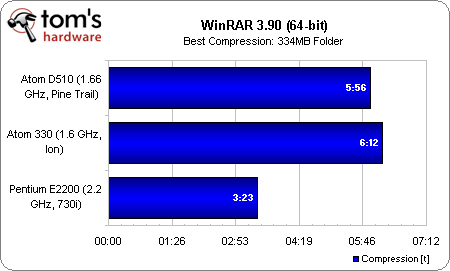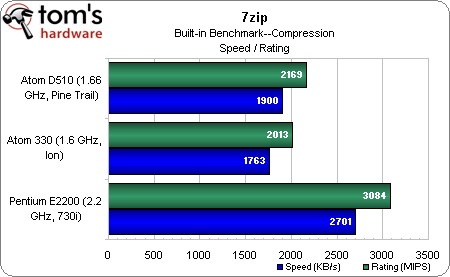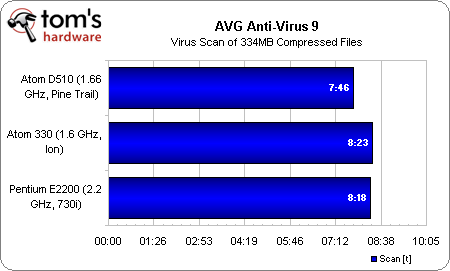Intel’s Atom D510 And NM10 Express: Down The Pine Trail With D510MO
Benchmark Results: Productivity Apps
A slightly faster CPU, slightly more memory bandwidth, and a second-generation Intel SSD help the Atom D510 outperform the Atom 330/Ion combo. Intel’s Pentium E2200 remains a quicker choice, but the gap is smaller here than it was with any of the encoding titles.
7zip is another one we’ve been asked to add—it’s free, after all, and well-optimized for threading (unlike WinZip, which was becoming a particularly boring app to analyze).
Here we have two results from the compression side of the metric, which measures in overall speed (KB/s) and an overall rating (in MIPS). The newer Atom D510 edges out the Atom 330, while Intel’s Pentium E2200 beats both of them. Interestingly, though, the margin isn’t as large, and the two Atom CPUs actually show fairly well.
In a somewhat perplexing turn of events, the Atom D510 turns out to finish our AVG test faster than not only Intel’s Atom 330, but also its Pentium E2200.
From here, it’s worth noting that we didn’t run any gaming benchmarks. For an idea of how the Atom 330 fares with Nvidia’s Ion chipset, you can check out this page of results in Left 4 Dead and the World of Warcraft. In short, you get moderately-playable results at 720x480 and 1280x720. But the scores are decidedly limited by processor performance—not the graphics engine.
On the other hand, Intel’s GMA 3150 graphics engine is wholly incapable of gaming. We fired up Left 4 Dead 2 at 800x600 and got a slide show. It goes without saying that under no circumstance will you be gaming on an Atom D510/NM10 configuration.
Get Tom's Hardware's best news and in-depth reviews, straight to your inbox.
Current page: Benchmark Results: Productivity Apps
Prev Page Benchmark Results: Transcoding Next Page Power Consumption-
It certainly is an improvement over the weak hearted Atom but I was expecting a bit more bang for the CPU's capabilities. Hopefully this will make Mini-ITX boards cheaper and more readily available for small servers and back up applications.Reply
-
scook9 My dad was looking at netbooks because he wanted something portable. What he ended up buying was the Dell Inspiron Mini 11z (not normally an inspiron fan). It has a Pentium Dual Core and the GM45 chipset (with HDMI output not VGA). This little 11" notebook gets over 6 hours of battery life and will run circles around either generation of atom processors and their chipsets/graphics. Yes the 11z did cost more than the other netbooks, but you got alot more for it, something to think about :)Reply -
matt87_50 wow, thats pretty terrible, one wonders how much better that new cpu integrated graphics is than the old chip set integrated? as basic as the ion system is, you can do anything with it, media center decoding HD, playing a couple of games, and as a file server, all with the lowest power consumption, this new one seems like its only good for the latter, and its only 3W less power.Reply
however, a file server / NAS alternative with the lowest possible power consumption is exactly what I'm after, so maybe its perfect for me, but I'd probably still go ION just because of the flexibility it offers in the future, should I get a new file server to replace it.
as for netbooks. If its a computer, I wanna be able to play games on it, and lets not forget about flash going 3D and hardware accelerated, I'd still go ION.
honestly, I wonder how they could make a GPU that crap in this day and age, the one in the iPhone and droid would be more powerful... -
little-ninja-man I just hop with this lower power usage we might see dual core atoms in netbooksReply -
liquidsnake718 I guess its not bad for beginners. I also have a netbook as my 3rd option.... I am rather enjoying the portability and functionality. As a HTCP or mini media center this sounds interesting for beginners that dont know how to build a PC... its almost plug and play..... this is a good option for them. I would prefer to get a mini-ITX board with at least a core 2 duo and build from there...... but then again, a PS2 is currently the king of this realm and you cannot compare as it has an HDMI, Great games, blu-ray, wifi, and everything one would need in this segment. Sorry the Cell is still far superior in this field!Reply -
tacoslave http://www.newegg.com/Product/Product.aspx?Item=N82E16813128342Reply
http://www.newegg.com/Product/Product.aspx?Item=N82E16819103706
quad core plus micro atx = amd win
-
djiezes Lack of HDMI, DVI or hardware accelerated decoding for MPEG4, x264 or h264 really does not make sense for a CPU/chipset that orients itself towards the desktop.Reply
Originally I thought this new chip might've made sense for htpc use. ION still beats it & ION2 is coming soon. An ordinary low powered desktop CPU for htpc use still makes more sense. AMDs Athlon X2 240E for example (45W) or maybe an Intel Pentium E3200 or alike. -
djiezes Lack of HDMI, DVI or hardware accelerated decoding for MPEG4, x264 or h264 really does not make sense for a CPU/chipset that orients itself towards the desktop.Reply
Originally I thought this new chip might've made sense for htpc use. ION still beats it & ION2 is coming soon. An ordinary low powered desktop CPU for htpc use still makes more sense. AMDs Athlon X2 240E for example (45W) or maybe an Intel Pentium E3200 or alike. -
yankeeDDL I have a question regarding the power efficiency. We see that in most tasks the Atoms are about 2X slower than the Pentium, and it seems to consume about 3~3,5X less under load.Reply
I wonder if a real/fair comparison of power consumption should be made differently.
For example: if I watch a DVD on an Atom I need, say, 100% CPU, while on a Pentium I will need only 50% of it.
So I will have the Atom burning power under full load vs 50% of the Pentium.
In other words: the Pentium is much more powerful, so it does not need to run full speed to do the same.
So, is there really an advantage in the Atom? Can you get the power/performance ratio of an Atom by simply underclocking a Pentium by few %?



